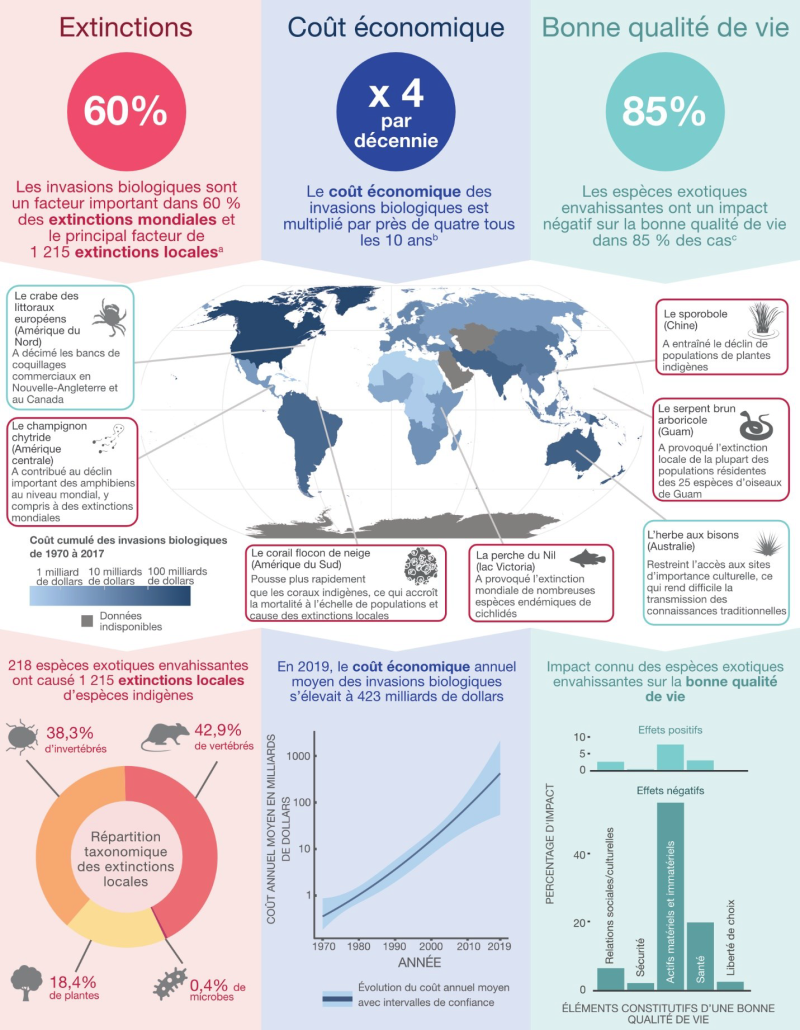
"60% of species extinctions are caused by biological invasions"
The report for decision-makers produced following the tenth plenary session of the Intergovernmental Science-Policy Platform on Biodiversity and Ecosystem Services (IPBES) in Bonn has been published. It highlights the vast damage caused by invasive alien species. These threaten entire ecosystems, represent huge financial costs and reduce the quality of life of many people. The ecologist Martine Hossaert-McKey explains.
You took part in the tenth session of the Intergovernmental Platform on Biodiversity and Ecosystem Services (IPBES) from August 28th to September 2nd in Bonn, Germany. What was the objective of this event?
Martine Hossaert-McKey :[1] This plenary session at the IPBES (see box) aimed to assess the impact of invasive alien species. These are one of the five main causes of biodiversity loss on the global scale. The threat they represent is already well known to researchers but this new report provides a review of thirteen thousand scientific publications from all over the world.
At the plenary session, we worked on making the scientific definitions in the report perfectly understandable for decision-makers so they could fully take into account the true scale of the problem which is well established scientifically. Over 35,000 plant and animal species settle in ecosystems where they have been transported by humans, intentionally or otherwise. 3500 of these species cause particularly dramatic problems by competing with or even causing the extinction of local species and also affect humans. 40% of these species are vertebrates and almost 40% are insects. The fire ant that invades the prairies of the United States and the tiger mosquito in France are examples of invasive species that can have a direct impact on people's quality of life and even cause immediate and significant health risks.
The report also explains how invasive alien species arrive in the places where they cause such problems. Generally they may be thought to be transported through trade routes in ornamental plants or food products but there are actually other dispersal routes. Such alien species may be brought in directly or indirectly with goods or vehicles in the marine environment and on land. In all cases, human factors ranging from excessive international transport, the over-exploitation of natural resources and imbalances created in ecosystems right up to climate change are driving this vast increase in the transportation, establishment and invasion of exotic species.
What are the IPBES's main conclusions on this subject?
M. H.-M. : Invasive alien species represent an economic cost of hundreds of billions of dollars in addition to their environmental impact. The latest scientific articles on this issue are real revelations intended to make waves, showing as they do that the costs of this are much significant than previously thought. These are very important elements for decision-makers, the aim being to encourage them to take action. We are also putting forward solutions. The most obvious ideas are to strengthen border controls and, above all, to manage ecosystems in zones of the world where such invasions are taking place but these are not the only measures required, We also show how this is a dynamic problem that can only get worse if nothing is done.
The report shows that 60% of species extinctions are caused by biological invasions and that the environmental cost of such invasions will be multiplied by four every ten years if the situation only stagnates. And in reality it is continually getting worse. This would mean that 85% of invasive alien species will have a negative impact on our quality of life. Finally, we stress the fact that many invasive species have yet to be declared as such notably due to the lack of peer-reviewed data in certain regions of the world that have been the subject of less scientific study.
What role do CNRS researchers play within the IPBES?
M. H.-M. : At the IPBES, as a researcher and member of the delegation from the CNRS's Institute of Ecology and Environment (INEE) along with Philippe Grandcolas [2], ], one of my roles is to assist legal specialists from the French Ministries of Ecological Transition and of Territorial Cohesion and diplomats from the Ministry of Foreign Affairs when the summaries of the reports are proofread and approved. Researchers also provide support during negotiations if scientific clarification is required as regards the wording of the texts approved during the plenary assembly.
However, before the plenary sessions we identify the French scientists with the right expertise to summarise the scientific literature on the subject. For example, this makes it possible to best estimate the impact of an invasive species in a given region or to understand more about the process of transport, establishment or invasion by exotic species. This means CNRS researchers work as co-rapporteurs and even as the main authors of certain chapters of global assessments.
After an assessment topic is chosen by government representatives it takes three to four years for the corresponding scientific report to be published. An exhaustive consultation of thousands of peer-reviewed scientific publications is extremely time-consuming and we also need to add the study of grey literature such as administrative documents, reports by companies, NGOs or associations.
Next, there is a series of re-readings of the reports with an initial peer review of the general plan for the report. The researchers then check that all the right scientific literature has been covered. Finally, we aim to make the summary for decision-makers at the plenary session as complete and comprehensible as possible. In France, the French Foundation for Biodiversity Research (FRB) centralises all of this work.
As an example, I personally took part in proofreading the assessment report on 'Pollinators, pollination and food production' and its summary for decision-makers along with a chapter on the use of wild species. Also, as a scientific advisor for French overseas territories at the INEE, I was able to provide particular insight into French Guiana and its Amazonian Park and make sure these were fully taken into account. All of this work is important to provide robust support for the CNRS Institutes in their discussions with the various government agencies attending the IPBES sessions.
[1] Martine Hossaert-McKey is a CNRS Research Professor at the Center for Functional and Evolutionary Ecology (CEFE, CNRS/EPHE – PSL/IRD/University of Montpellier) and Scientific Advisor for Biodiversity and French Overseas Territories at the CNRS Institute of Ecology and Environment (INEE).
[2] The Deputy Scientific Director of the INEE and also a member of the French delegation.
The Intergovernmental Science-Policy Platform on Biodiversity and Ecosystem Services (IPBES)
The IPBES is an intergovernmental platform that works on the state of the world's biodiversity and ecosystem services. Representatives of 150 countries attend its annual plenary meetings at which scientists, experts and politicians validate the assessments presented by international groups of scientific experts.



